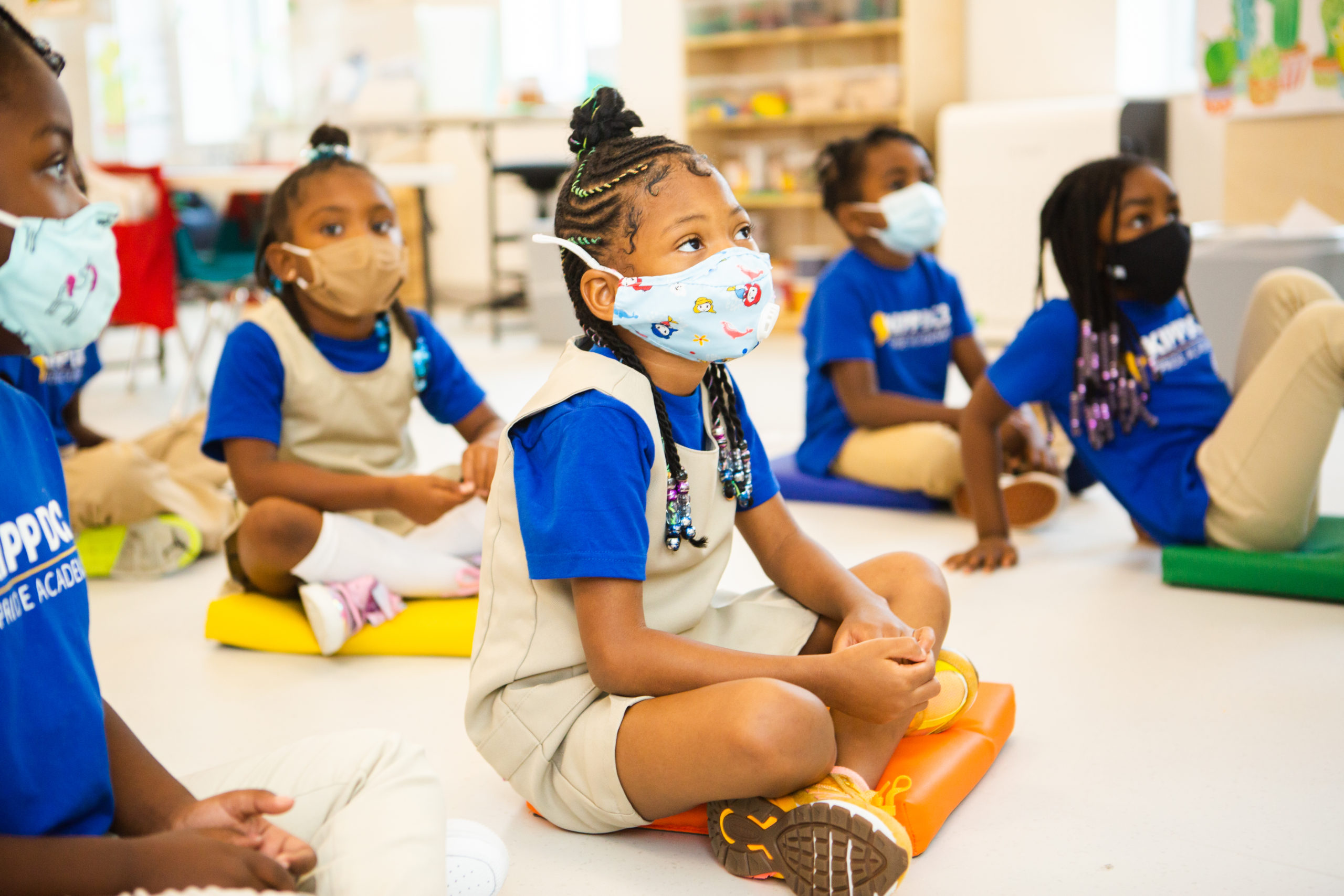
Out-of-school time (OST) programs, such as afterschool and summer programs, are important to many families the District of Columbia. Access to out-of-school time (OST) programming is dependent on many factors, including the availability of seats and location of programs. This article presents information on the number and location of subsidized OST programs in the District of Columbia, focusing on afterschool and summer programs by location and by two main age groups: prekindergarten (PK3) to 8th grade and grades 9 to 12.
About this series
This publication is part of a series adapted from our full report commissioned by the District of Columbia Deputy Mayor for Education (DME), Needs assessment of out-of-school time programs in the District of Columbia.
Other publications in this series include:
- Chart of the week: D.C. children face unequal access to out-of-school time programs
- Demand for out-of-school time programming shifts, depending on where students live versus where they go to school
- How many more out-of-school time seats does the District of Columbia need?
- How close are out-of-school time programs to where students live?
- Who provides of out-of-school time programs in the District of Columbia?
- Out-of-school time programs in the District of Columbia: Parent and guardian experiences
- Recommendations for out-of-school time programs in the District of Columbia
Access the underlying original report in printable PDF format here.
Access to out of school time (OST) programming is dependent on many factors, including the availability of seats and location of programs. This article presents information on subsidized OST programs in the District of Columbia, focusing on afterschool and summer programs by location and by two main age groups: prekindergarten (PK3) to 8th grade and grades 9 to 12. OST program counts include programs that are located in and operated by D.C. Public Schools and D.C. public charter schools; programs that are operated by other government agencies, specifically those provided by the Department of Parks and Recreation; and programs that are operated by community-based organizations, many of whom receive public funding. Included in the overall program counts for high school aged youth (grades 9-12) is the Mayor Marion S. Barry Summer Youth Employment Program (MBSYEP), which is the only program in this analysis that is reported by the ward participants live in, rather than program location.1
During school year 2021-22, there were 150 different providers offering 474 different OST programs serving the District’s public school students through afterschool and summer programming. These included 88 different Community Based Organizations (CBOs) offering 92 programs during the school year and the summer, 55 afterschool programs located in DCPS Title I schools, 58 programs located in different public charter schools and non-Title I DCPS schools, 254 different programs (with 670 different sessions) offered by the Department of Parks and Recreation including summer camps, afterschool programs, and seasonal sports activities, 14 different summer programs offered by DCPS, and the Marion Barry Summer Youth Employment Program offered by the Department of Employment Services.
Count of providers and OST programs, school year 2021-22

These providers collectively offered 30,360 afterschool seats in OST programs at the PK3 through grade 8 level, and 6,090 seats at the high school level. In addition, there were 16,434 seats in summer programs for elementary and middle school students, and 15,044 seats for high school students, of which, approximately 8,350 were seats in the MBSYEP.
OST program providers also provided before school programming, mainly serving students attending elementary and middle schools. Students could also attend seasonal sports organized by DPR (such as football in the fall, basketball in the winter, etc.) but these were organized around practices and games and not offered consistently through the week. There were also programs offered during seasonal breaks, single day closures and other times, and these were mostly organized by CBOs, public charter schools, or DCPS schools that are not a part of the Title I program.
OST seats by program time, school year 2021-22

Distribution of program seats by location
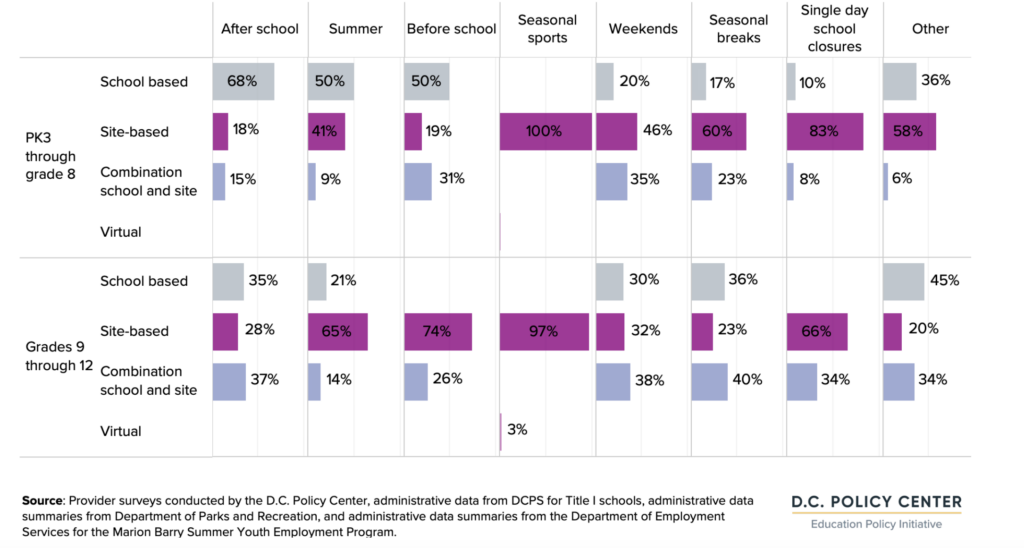
Proximity to students’ school is important, especially for afterschool programs for younger students. Sixty-eight percent of the seats in afterschool programs serving PK3 through grade 8 are school-based, and another 15 percent are at least partially organized at students’ schools. For older students, proximity to school is less important, since these students can independently travel to sites other than school. At this grade band, only 35 percent of afterschool seats are located in schools. That share is even lower, at 21 percent, for summer programs.
Program providers
The main providers of subsidized afterschool programs in the District are schools and community-based programs, DCPS, all Title I schools, public charter schools and non-Title I DCPS schools that pay for programs through a combination of funding sources (including per pupil formula funding and school budgets), the Department of Parks and Recreation (specifically for summer programs), and the Department of Employment Services (DOES), which offers the Marion Barry Summer Youth Employment Program for youth between the ages of 16 and 24.2
Community based organizations
CBOs are the largest source of seats for OST programs.3 They operate at every grade level and provide programs throughout the year at different times of the day including afterschool, summer, before school, weekdays, and seasonal programs. CBOs ran programs at both school sites and independent sites. In school year 2021-22, 64 different CBOs offered afterschool programs providing 13,936 seats serving students attending PK3 through grade 8. In addition, they provided 46 different programs in the summer, with 8,330 seats. Many CBOs also offered before-school programs, weekend programs, programs during seasonal breaks, and programs through single-day school closures.
At the high school level, CBOs administered 47 afterschool programs with 4,381 seats serving high school students and 37 summer programs providing 3,525 seats and provided programming during seasonal breaks and weekends.
CBO programs, and seat capacity, school year 2021-22
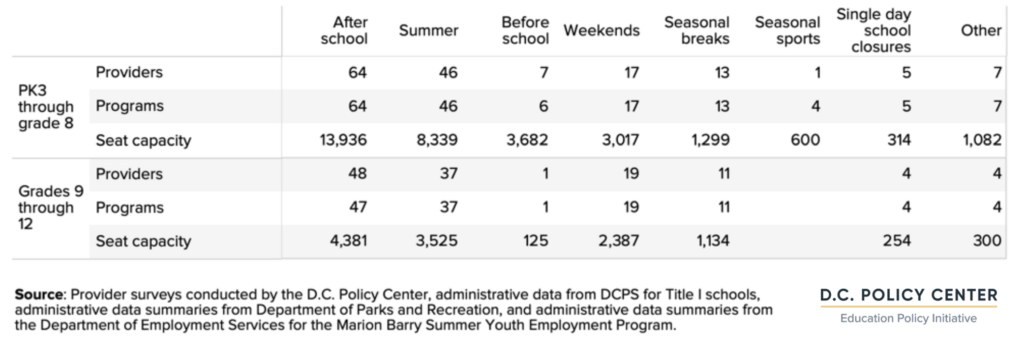
Schools
DCPS receives federal funding to run afterschool programs in all its Title I schools. These programs are offered afterschool or during the summer. In addition, public charter schools and non-Title I schools organize OST programs sometimes using their school budgets, and sometimes with partial help from PTAs or fees collected from families. Non-Title I schools and charter schools offer programs in before- and afterschool hours, during the summers, weekends, seasonal breaks, or during single day school closures.4
An estimated 14,994 OST seats were available in school year 2021 to 2022 in afterschool programs organized by schools for students attending PK3 through grade 8 through 108 school-based programs. In addition, schools offered 5,417 summer seats through 24 different programs, 5,973 before-school seats through 34 programs (exclusively organized by non-Title I and charter schools), and 2530 weekend seats through 12 different programs.
Schools are less likely to organize OST programs for older students attending grades 9 through 12, especially during afterschool hours. At this level, there were 1,397 afterschool seats offered through 15 different programs. Summer seat capacity for older youth is higher with 3,117 seats, bolstered by the 9 DCPS programs.
DCPS and public charter school programs, and seat capacity, school year 2021-22
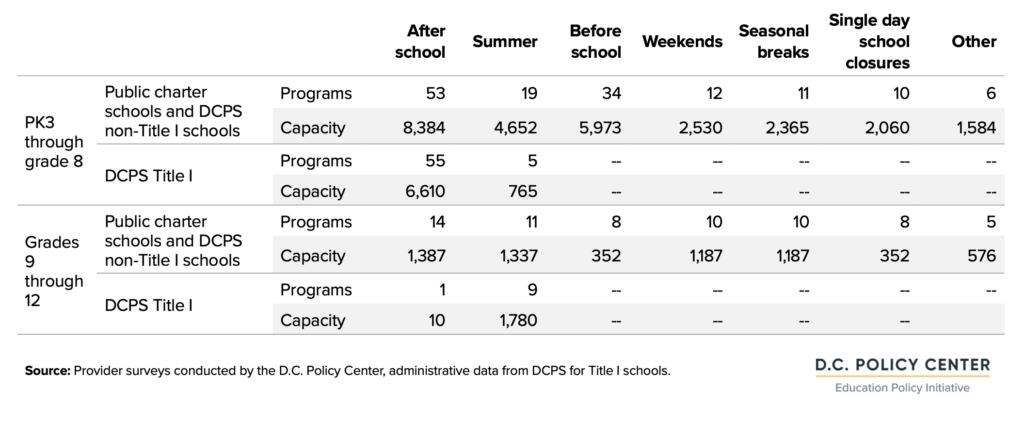
Department of Parks and Recreation
During school year 2021-22, the Department of Parks and Recreation (DPR) rans 88 different afterschool programs with 1,430 seats for children and youth attending PK3 through grade 8. (These seats are open to all children, and not just D.C. public school students.) In addition, DPR offered 2,679 seats in 91 different summer camps, and a handful of seats during seasonal breaks, single day closures, and other times. The largest number of seats available from DPR for this grade band is through seasonal sports. DPR served 7,098 students in this grade band through 126 sports programs. DPR also offers some programs for older youth, but these are of relatively small scale compared to programs offered for elementary and middle school students.
Department of Parks and Recreation seat capacity, school year 2021-22

Mayor Marion S. Barry Summer Youth Employment Program
During school year 2021-22 an estimated 8,354 youth participated in the Mayor Marion S. Barry Summer Youth Employment Program (MBSYEP), managed by the Department of Employment Services (DOES). While MBSYEP is a youth employment program and not the same in structure as other OST programs, it provides important and popular programming to high school aged youth in the District of Columbia. The MBSYEP is open to youth aged 14 to 24. During this year there were 12,469 total seats, but we have estimated the percentage of high school aged youth using age distribution data from 2021.5
Data limitations
The reported seat counts include seats reported by providers. These are likely to be undercounts: First, for CBOs, public charter schools and non-Title I schools, only seats reported by those that participated in the D.C. Policy Center surveys are reported. Second, as noted in the introduction section, not all seats at licensed child development centers are likely included in the counts.
Program capacity data were often provided for all programs, across multiple locations, and serving multiple grade bands. When capacity could not be determined between locations or specific grade bands, program capacity numbers were evenly split between locations and ages. See the methodology section of the Appendix for a more thorough discussion of data limitations.
Program capacity by ward
Availability of OST programs varies greatly across wards and at different grade band levels.
Afterschool programs
Afterschool programs are most concentrated in Wards 5 and 8 at the elementary and middle school level, followed by Wards 4 and 7. There are only a handful of seats in Ward 3, provided by CBOs and DPR. DPR programs are distributed all around the city, but they tend to be small in scale compared to programs offered by CBOs and schools.
Afterschool OST seats by ward and grade band
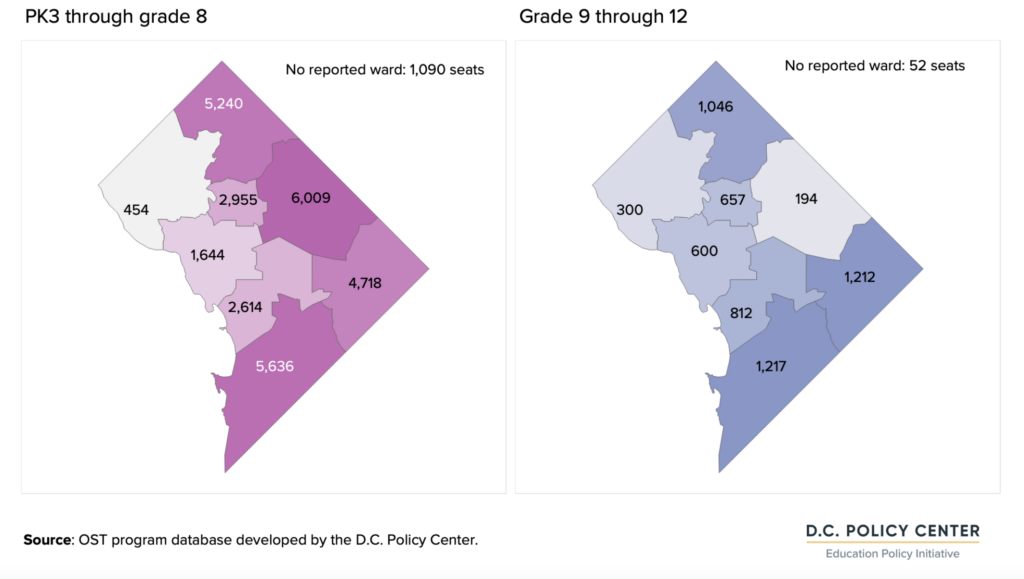
For older youth attending high school, afterschool seats are most heavily concentrated in Wards 4, 7, and 8. Again, CBOs are the only source of programs in neighborhoods west of the Rock Creek Park. Schools offer only a handful of programs for youth in this age group, and DPR has smaller programs, but none in Wards 2 and 3.
Afterschool seats by location and provider, school year 2021-22
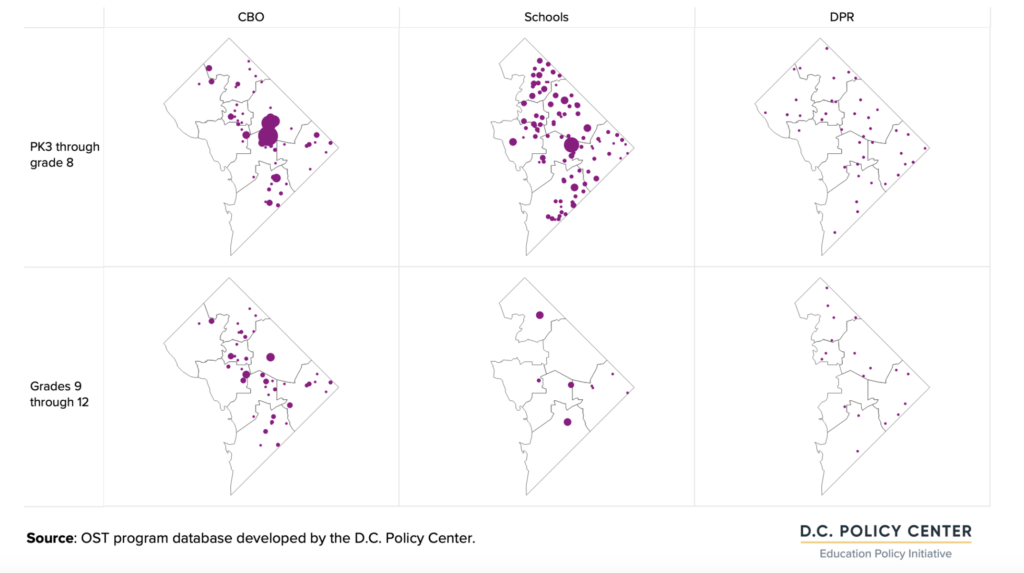
Summer programs
At the elementary and middle school level, summer programs are most concentrated in Wards 7 and 8, followed by Wards 4 and 6. Overall, there are fewer summer seats for students at this grade band level, but in Ward 3, there are more summer seats compared to afterschool seats, provided by CBOs and DPR. Just like afterschool programs, DPR programs are distributed all around the city, but they tend to be small in scale compared to programs offered by CBOs and schools. And just like afterschool programs, there are no summer seats provided by DPCS in Ward 3 (there are no charter schools in Ward 3).
For older youth attending high school, it is more difficult to determine where summer seats are. When including the MBSYEP, which reports participants by their ward of residence, the greatest share of seats are in Ward 7 and 8. But broken down by provider type and by program location, a larger number of seats are located in Wards 5, 6, and 8 for CBOs and in Wards 1 and 8 for DCPS and public charter schools. DCPS runs a summer program for high school students out of Jackson Reed high school in Ward 3. DPR has only three programs for youth in this grade band—two located in Ward 7, and one in Ward 5.
Summer OST seats by ward and grade band
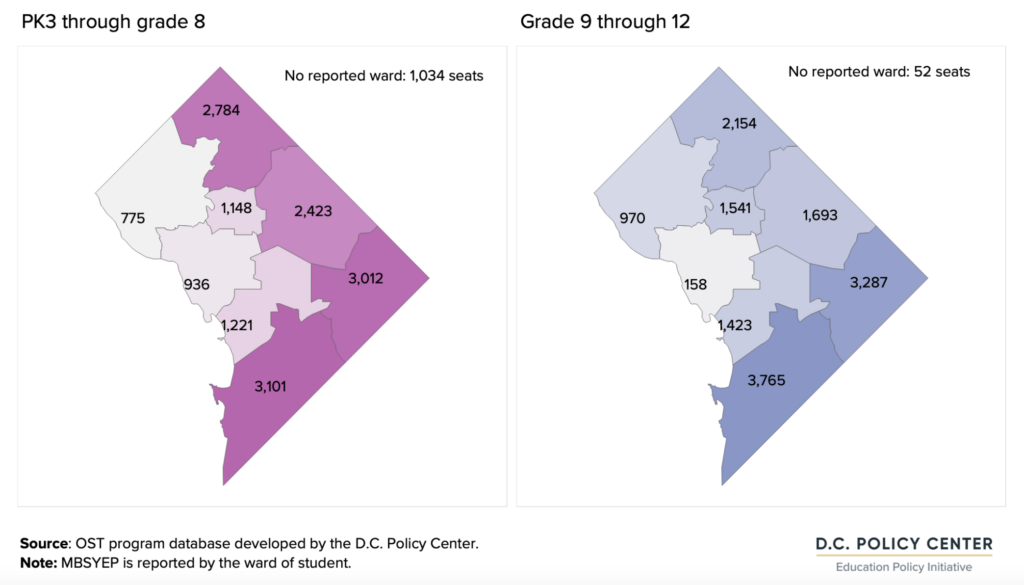
Summer seats by location and provider, school year 2021-22
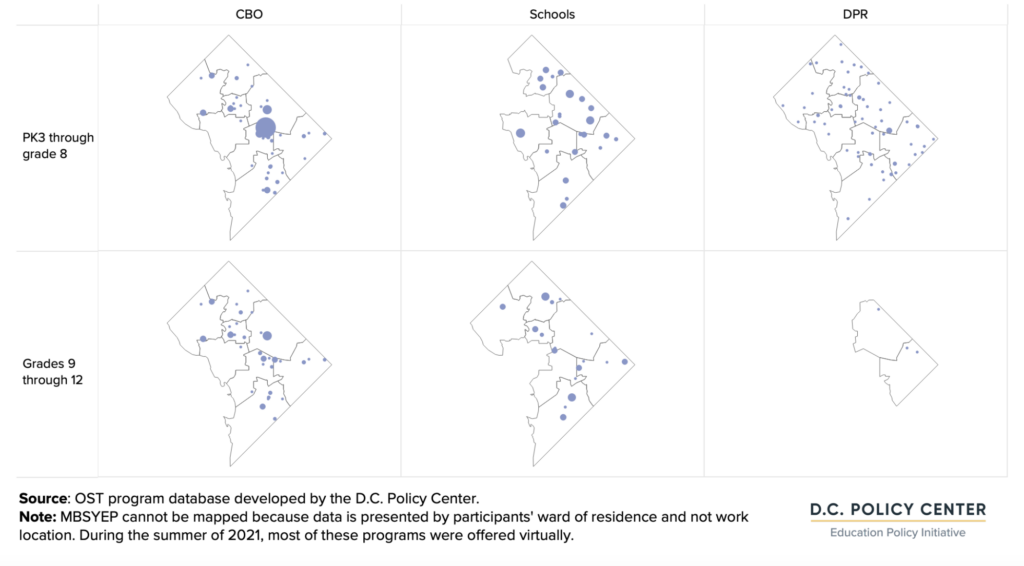
Detailed information on where D.C. public school students live and go to school, estimated gaps across the city and at the neighborhood level, and the experience of providers and families can be found in the main text of our report.
Endnotes
- Because of this, MBSYEP are not included in location-based analyses in this report or in Ward-level counts.
- There are also some slots funded by OSSE in licensed child development facilities, but for reasons outlined in the Limitations and Omissions section, these slots are not included in this study.
- Capacity data was obtained from providers through a D.C. Policy Center administered survey, found in the Appendix, as well as through grant data from the Office of the State Superintendent of Education and some independent provider contributions of data.
- Capacity data was obtained from non-Title I schools and charter schools, through a D.C. Policy Center administered survey, found in the Appendix. Capacity data for Title I DCPS schools has been reported by DCPS.
- The data for the MBSYEP is obtained from DOES. During this year there were 12,469 total seats. We have estimated the percentage of high school aged youth using age distribution data for 2021 available at https://lims.dccouncil.gov/downloads/LIMS/51134/Introduction/RC24-0213-Introduction.pdf.
